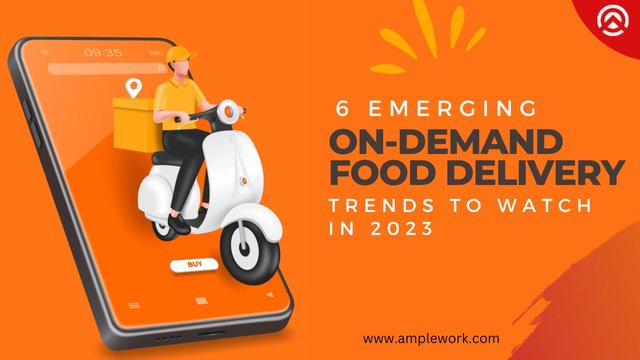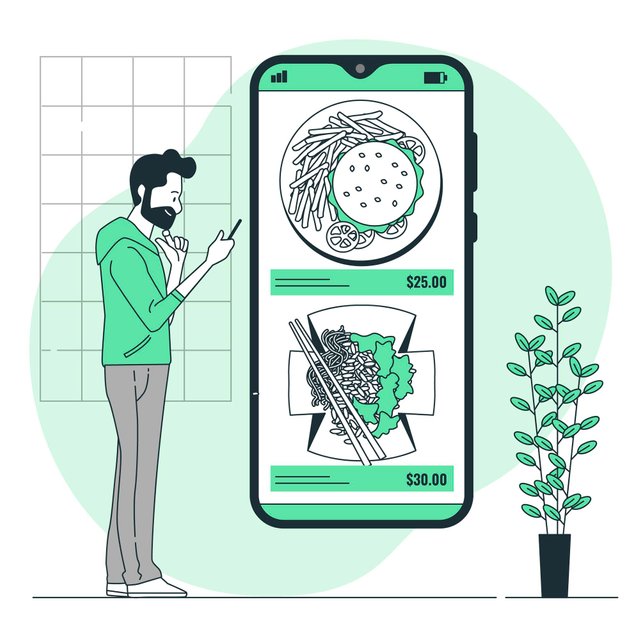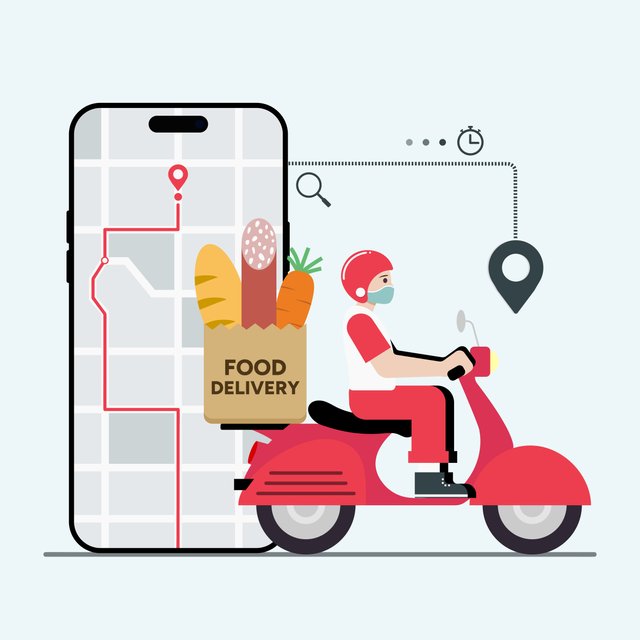
The on-demand food delivery industry has undergone phenomenal growth in recent times, revolutionizing the way people order and savor meals. Thanks to the proliferation of food delivery apps, customers have come to expect the convenience of receiving restaurant-quality food delivered straight to their doorstep. According to Statista, the Online Food Delivery market is set to generate a revenue of US$0.91tn by 2023 and is projected to grow at a Compound Annual Growth Rate (CAGR) of 12.33% from 2023 to 2027, resulting in an estimated market volume of US$1.45tn by 2027. As the industry continues to advance, several emerging trends are poised to define the future of food delivery.
To keep up with the constantly evolving and highly competitive food delivery industry, it's essential for food delivery app development company to stay ahead of the curve. In this article, we'll explore seven on-demand food delivery trends that are predicted to shape the industry in the upcoming years. From sustainability and artificial intelligence to hyperlocal delivery and contactless payments, these trends are reshaping the way food is delivered, providing exciting opportunities for food app developers to innovate and meet the changing demands of consumers.
1 .Sustainability Emerges as Key Focus in the Food Delivery Industry
As sustainability gains importance among consumers, the food delivery industry is following suit. Food delivery apps are increasingly adopting eco-friendly practices in their operations to meet the growing demand for sustainability.
For instance, certain apps are employing biodegradable packaging composed of recycled materials, and others are emphasizing the use of locally-sourced ingredients to decrease carbon emissions caused by transportation. Moreover, initiatives are underway to decrease food waste, including food donation programs and the redistribution of excess food. These sustainability endeavors not only support a more eco-friendly future but also align with the values of eco-conscious consumers, making it a crucial trend to monitor in the forthcoming years.
2. Advancements in AI and Machine Learning Reshape the Food Delivery Industry
In the on-demand food delivery industry, Artificial Intelligence (AI) and Machine Learning (ML) technologies are transforming various facets of the delivery process. For instance, route optimization algorithms based on AI are employed to identify the quickest delivery routes, resulting in reduced delivery time and an enhanced customer experience.
Machine Learning (ML) algorithms are also employed to examine user data and furnish customized recommendations, including restaurant and dish suggestions based on user preferences and order history. Additionally, AI-powered demand forecasting aids restaurants in managing their inventory better and reducing food waste. As AI and ML continue to be integrated into food delivery apps, users can anticipate even more sophisticated and personalized experiences in the future.

3. Ghost Kitchens and Virtual Restaurants Gain Traction in the Food Delivery Industry
Ghost kitchens, also called virtual or dark kitchens, are commercial kitchens that focus entirely on fulfilling online orders, without any physical dining options. Meanwhile, virtual restaurants are exclusively online-based eateries that operate solely through food delivery apps.
In the on-demand food delivery app industry, Ghost Kitchens and Virtual Restaurants are gaining popularity, offering restaurants cost-effective solutions to broaden their reach without requiring physical dining spaces. With more flexibility in terms of location and reduced overhead expenses, these concepts make it easier for new players to enter the food delivery market. This trend is predicted to keep growing, providing additional options for consumers and opening up more opportunities for businesses.
4. Using AR and VR Technologies in Food Delivery Apps
Food delivery apps are incorporating AR and VR technologies to provide users with an interactive and immersive ordering experience. With AR, users can view virtual images of dishes superimposed onto their real-world environment using their smartphones, helping them make more informed choices. This technology is revolutionizing the way people order food online, providing a new level of convenience and engagement.
On the other hand, VR technology is now being utilized to create simulated dining experiences, enabling individuals to "dine-in" at restaurants from the convenience of their own homes. This new approach offers distinctive and unforgettable dining experiences. Meanwhile, the incorporation of AR and VR in food delivery applications is still in its initial phases, but it is anticipated to gain traction in the future, providing users with unique methods to engage with these apps.
5. Contactless Deliveries and Payment Options
The food delivery industry has witnessed a surge in the adoption of contactless deliveries amid the current global pandemic. By reducing the need for physical interaction between delivery drivers and customers, contactless deliveries help to minimize the risk of disease transmission. A number of food delivery applications have introduced contactless delivery alternatives that enable drivers to leave orders at customers' doorsteps without any direct contact.
Alongside the growing need for contactless deliveries, there is also a rising desire for payment options that do not require physical contact. Cashless payment methods such as digital wallets and mobile payments are gaining traction as they offer a convenient and contact-free way for customers to settle their food delivery bills. This trend is projected to persist over the next few years as consumers prioritize safety and convenience when ordering food.
6. Hyperlocal Delivery and Personalized Experiences
Hyperlocal delivery pertains to the transportation of products from nearby sources situated within a small geographic radius. In the food delivery sector, hyperlocal delivery enables faster delivery times and the provision of fresher food, as orders are sourced from local restaurants or suppliers. Numerous food delivery applications have placed emphasis on hyperlocal delivery to enhance the speed and efficiency of their delivery services for their clientele.
Apart from hyperlocal delivery, the food delivery sector is also placing great importance on personalized experiences. Personalization methods, including user profiling, analysis of order history, and employment of machine learning algorithms, are utilized to offer customized recommendations, discounts, and promotions to customers. This leads to a more personalized and tailored experience, which in turn enhances customer engagement and loyalty. Hyperlocal delivery and personalized experiences are anticipated to be significant trends in the near future, as users demand faster and more personalized food delivery services from mobile applications.

Cost of Developing an On-Demand Food Delivery App?
The cost of developing a customized on-demand food delivery app is influenced by several factors that can affect the final expense. These factors include the intricacy of features, technology stack, design, location of the development team, among others. Below are some ballpark cost estimates associated with on-demand food delivery app development: -
Basic App: A fundamental on-demand food delivery app that comprises necessary features such as user registration, menu browsing, ordering, payment integration, and a simple admin dashboard could be developed for approximately $15,000 to $30,000.
Advanced App: For an on-demand food delivery app with advanced features such as real-time order tracking, push notifications, multiple payment gateways, social media integration, and a sophisticated admin dashboard, the estimated cost ranges from $30,000 to $50,000.
Complex App: The development cost for a complex on-demand food delivery app with advanced features such as AI-based recommendations, chatbot integration, multi-language and multi-currency support, third-party API integrations, and a comprehensive admin panel with analytics can exceed $50,000.
It's crucial to bear in mind that these figures are only approximate estimates and the actual cost of developing an on-demand food delivery app may vary depending on factors such as the app's specific requirements, customization needs, and the proficiency of the development team. To get a precise cost estimate based on your particular project requirements, it's advisable to consult with an experienced food delivery app development company.
Furthermore, it's important to consider ongoing expenses like app maintenance, updates, and server/hosting fees, which should be factored into long-term budget planning.
Read more: How to Build a Food Delivery App ? A step-by-step guide
Conclusion
To sum up, the on-demand food delivery sector is projected to maintain its upward trend in the future, propelled by inventive technologies and a focus on consumer needs. Developers of food delivery apps can stay ahead in the industry and provide state-of-the-art solutions to their clients by monitoring these emerging trends and adapting to the evolving landscape.